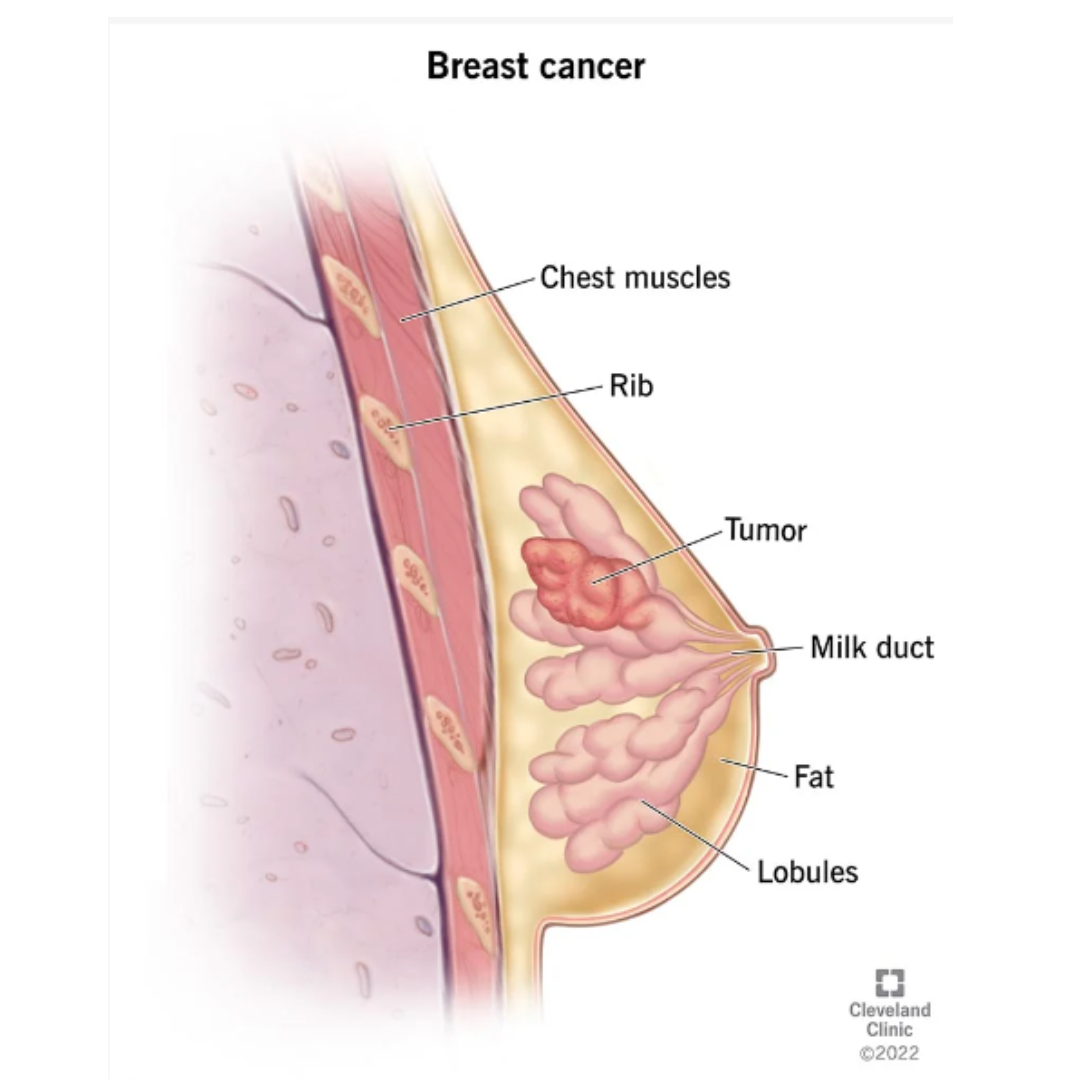Breast cancer occurs when there is a transformation of normal breast cells into cancerous cells that rapidly multiply and create tumors. While breast cancer is most commonly found in women and individuals assigned female at birth, particularly those aged 50 and above, it can also impact men and individuals assigned male at birth, as well as younger women. Medical professionals often employ approaches like surgical tumor removal or treatments aimed at eliminating cancerous cells to address breast cancer.
Overview
What is breast cancer?
Breast cancer is a prevalent form of cancer that impacts women and individuals assigned female at birth (AFAB). This condition arises when cancerous cells within the breast multiply and form tumors. Approximately 80% of breast cancer cases are classified as invasive, indicating the potential for tumors to spread from the breast to other parts of the body.
While breast cancer predominantly affects women aged 50 and above, it can also manifest in younger women and individuals AFAB. Moreover, men and those assigned male at birth (AMAB) are not immune to the possibility of developing breast cancer.

Breast cancer types
Healthcare professionals categorize cancer types and subtypes to customize treatment for maximum effectiveness while minimizing side effects. Common breast cancer varieties include:
- Invasive Ductal Carcinoma (IDC): Originating in the milk ducts and spreading to nearby breast tissue, this is the most prevalent type in the United States.
- Lobular Breast Cancer: This cancer starts in the milk-producing lobules within the breast and often extends to neighboring breast tissue. It’s the second most common type in the United States.
- Ductal Carcinoma In Situ (DCIS): Similar to IDC, DCIS initiates in the milk ducts but does not progress beyond them.
Less common breast cancer types comprise:
- Triple-Negative Breast Cancer (TNBC): This aggressive, invasive cancer spreads more rapidly than others.
- Inflammatory Breast Cancer (IBC): A rare and swiftly advancing cancer that appears as a rash on the breast. It’s uncommon in the United States.
- Paget’s Disease of the Breast: This infrequent cancer affects the nipple’s skin and may resemble a rash. It accounts for less than 4% of all breast cancers.
Breast cancer subtypes are determined based on receptor cell status, which relates to protein molecules on or within cell surfaces. These receptors can interact with certain substances in the blood, such as estrogen and progesterone hormones, which assist in the growth of cancerous cells. Identifying whether cancer cells possess estrogen or progesterone receptors aids healthcare providers in devising a tailored treatment plan.
Subtypes encompass:
- ER-Positive (ER+) Breast Cancers with estrogen receptors.
- PR-Positive (PR+) Breast Cancers with progesterone receptors.
- HR-Positive (HR+) Breast Cancers with both estrogen and progesterone receptors.
- HR-Negative (HR-) Breast Cancers lacking estrogen or progesterone receptors.
- HER2-Positive (HER2+) Breast Cancers, characterized by elevated levels of the HER2 protein, which accelerates cancer cell growth. This subtype constitutes approximately 15% to 20% of all breast cancers.
Breast cancer Symptoms and Causes
What are breast cancer symptoms?
Breast cancer can manifest with various symptoms, some of which are quite distinctive, while others might be subtler and appear as unusual breast changes. In some cases, breast cancer might not present noticeable symptoms. However, when symptoms do occur, they can include:
- Alterations in the size, shape, or contour of the breast.
- The presence of a mass or lump, which can be as small as a pea.
- A lump or thickening in or around the breast or underarm that persists throughout your menstrual cycle.
- Changes in the appearance or texture of the skin on the breast or nipple, which may manifest as dimpling, puckering, scaliness, or inflammation. The skin might also appear discolored, such as red, purple, or darker than the surrounding area.
- The presence of a hardened, marble-like area beneath the skin.
- Discharge from the nipple, which can be blood-stained or clear.
Lesscommon breast cancer types comprise:
- Triple-Negative Breast Cancer (TNBC): This aggressive, invasive cancer spreads more rapidly than others.
- Inflammatory Breast Cancer (IBC): A rare and swiftly advancing cancer that appears as a rash on the breast. It’s uncommon in the United States.
- Paget’s Disease of the Breast: This infrequent cancer affects the nipple’s skin and may resemble a rash. It accounts for less than 4% of all breast cancers.
Breast cancer subtypes are determined based on receptor cell status, which relates to protein molecules on or within cell surfaces. These receptors can interact with certain substances in the blood, such as estrogen and progesterone hormones, which assist in the growth of cancerous cells. Identifying whether cancer cells possess estrogen or progesterone receptors aids healthcare providers in devising a tailored treatment plan.
Subtypes encompass:
- ER-Positive (ER+) Breast Cancers with estrogen receptors.
- PR-Positive (PR+) Breast Cancers with progesterone receptors.
- HR-Positive (HR+) Breast Cancers with both estrogen and progesterone receptors.
- HR-Negative (HR-) Breast Cancers lacking estrogen or progesterone receptors.
- HER2-Positive (HER2+) Breast Cancers, characterized by elevated levels of the HER2 protein, which accelerates cancer cell growth. This subtype constitutes approximately 15% to 20% of all breast cancers.
What cause breast cancer ?
Experts understand that breast cancer results from mutations in breast cells, causing them to transform into cancerous cells that divide and form tumors. While the precise triggers of these mutations remain unclear, research has identified several risk factors that may elevate the likelihood of developing breast cancer. These risk factors include:
- Age: Individuals aged 55 or older are at a higher risk.
- Sex: Women and individuals assigned female at birth (AFAB) are significantly more susceptible to this condition compared to men and individuals assigned male at birth (AMAB).
- Family History: If close relatives like parents, siblings, children, or other immediate family members have had breast cancer, your risk of developing the disease increases.
- Genetics: Up to 15% of breast cancer cases are attributed to inherited genetic mutations. Among the most prevalent genetic mutations are those affecting the BRCA1 and BRCA2 genes.
- Smoking: Tobacco use has been linked to various cancer types, including breast cancer.
- Alcohol Consumption: Research suggests that consuming alcoholic beverages may elevate the risk of breast cancer.
- Obesity: Having obesity is associated with an increased likelihood of developing breast cancer.
- Radiation Exposure: Individuals who have received radiation therapy in the past, particularly to areas like the head, neck, or chest, face a higher risk of breast cancer.
- Hormone Replacement Therapy (HRT): People who undergo hormone replacement therapy have an elevated risk of being diagnosed with breast cancer.
Diagnosis and Tests for Breast Cancer
Healthcare providers employ various methods to diagnose breast cancer, including:
- Physical Examinations: Providers may conduct physical examinations to check for signs of breast cancer.
- Mammograms: These X-ray images are crucial for detecting breast abnormalities.
- Breast Ultrasound: Ultrasounds are used to obtain detailed images of breast tissues.
- Breast Magnetic Resonance Imaging (MRI) Scan: MRI scans provide comprehensive views of breast tissue, aiding in diagnosis.
- Breast Biopsy: This procedure involves removing a sample of breast tissue for examination under a microscope to confirm the presence of cancerous cells.
- Immunohistochemistry Test: It checks for hormone receptors within cancerous cells.
- Genetic Tests: These tests help identify mutations that may be responsible for causing breast cancer.
Stages of Breast Cancer
Breast cancer is categorized into stages, which are essential for treatment planning and prognosis assessment. The stage of breast cancer depends on factors like tumor size, location, type, and whether cancer has spread to other parts of the body. The stages are as follows:
- Stage 0: The disease is noninvasive, confined to the breast ducts without spreading to other breast areas.
- Stage I: Cancerous cells are found in nearby breast tissue.
- Stage II: Cancer cells have formed tumors. Tumors may be smaller than 2 centimeters and may have spread to underarm lymph nodes, or they may be larger than 5 centimeters but haven’t reached underarm lymph nodes. Tumors at this stage can measure between 2 and 5 centimeters and may or may not involve nearby lymph nodes.
- Stage III: Breast cancer is present in nearby tissue and lymph nodes. This stage is commonly known as locally advanced breast cancer.
- Stage IV: Cancer has metastasized (spread) from the breast to other areas of the body, such as the bones, liver, lungs, or brain.
Management and Treatment
Breast Cancer Treatment Options
Surgery is the primary approach for treating breast cancer, but healthcare providers may also recommend additional treatments. Here are some common breast cancer treatment methods:
- Mastectomy: This involves the removal of the entire breast, which can be either a simple mastectomy (removing the breast tissue) or a radical mastectomy (removing breast tissue, lymph nodes, and chest muscles).
- Lumpectomy: Also known as breast-conserving surgery, a lumpectomy involves removing the cancerous tumor and a margin of surrounding healthy tissue, preserving most of the breast.
- Breast Reconstruction: Following a mastectomy, some individuals opt for breast reconstruction surgery to restore the appearance of the breast.
- Chemotherapy: This treatment uses drugs to target and eliminate cancer cells, and it can be administered before or after surgery.
- Radiation Therapy: This includes treatments like intraoperative radiation therapy (IORT), which uses targeted radiation to destroy cancer cells.
- Immunotherapy: Immunotherapy stimulates the immune system to identify and fight cancer cells.
- Hormone Therapy: Hormone therapy, including selective estrogen receptor modulator (SERM) therapy, is used when breast cancer is hormone receptor-positive, as it blocks hormones that fuel cancer growth.
- Targeted Therapy: Targeted therapy focuses on specific molecules involved in cancer growth and can be an effective treatment for certain types of breast cancer.
Breast Cancer Prevention and Risk Reduction
While it may not always be possible to prevent breast cancer, there are several measures you can take to lower your risk:
- Maintain a Healthy Weight: Achieving and maintaining a healthy weight suitable for you is crucial. Consult a healthcare provider for guidance on healthy weight management.
- Adopt a Balanced Diet: Some studies suggest that a diet rich in vegetables, fruits, calcium-rich dairy products, and lean protein can help reduce the risk of breast cancer. Reducing the consumption of red meat and processed meat may also be beneficial.
- Regular Physical Activity: Engaging in regular physical activity has been shown to lower the risk of breast cancer.
- Wear Nursing Bra: To offer comfort and support.
- Limit Alcohol Intake: Research indicates a link between alcohol consumption and breast cancer. It is recommended that women and individuals assigned female at birth (AFAB) limit alcohol consumption to one drink per day, as advised by the American Medical Association.
- Screening and Early Detection: Regular mammograms are vital for detecting tumors when they are too small to be felt. Additionally, conducting regular self-exams helps maintain breast health and may enable early detection of breast cancer.
- Genetic Screening: This involves testing for breast cancer-related genetic mutations.
- Medication: Some medications, such as tamoxifen, raloxifene, or aromatase inhibitors, may be recommended to lower the risk of breast cancer.
- Prophylactic Mastectomy: In some cases, preventive mastectomy (surgical removal of one or both breasts) may be considered.
Taking proactive steps toward risk reduction and early detection is essential in the fight against breast cancer, particularly for those with heightened risk factors. Consulting with a healthcare provider can provide personalized guidance and recommendations based on individual circumstances.


Leave a Reply